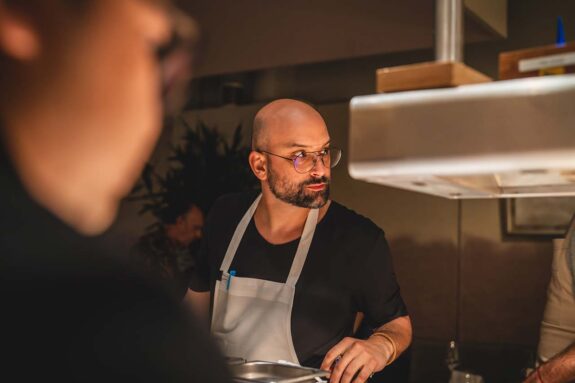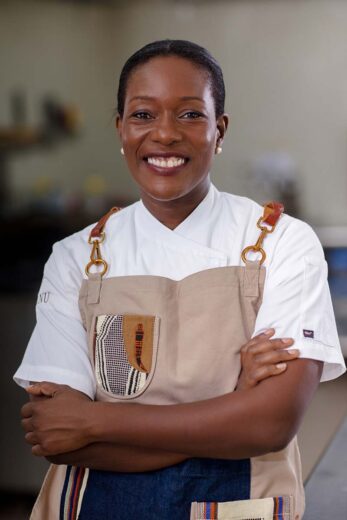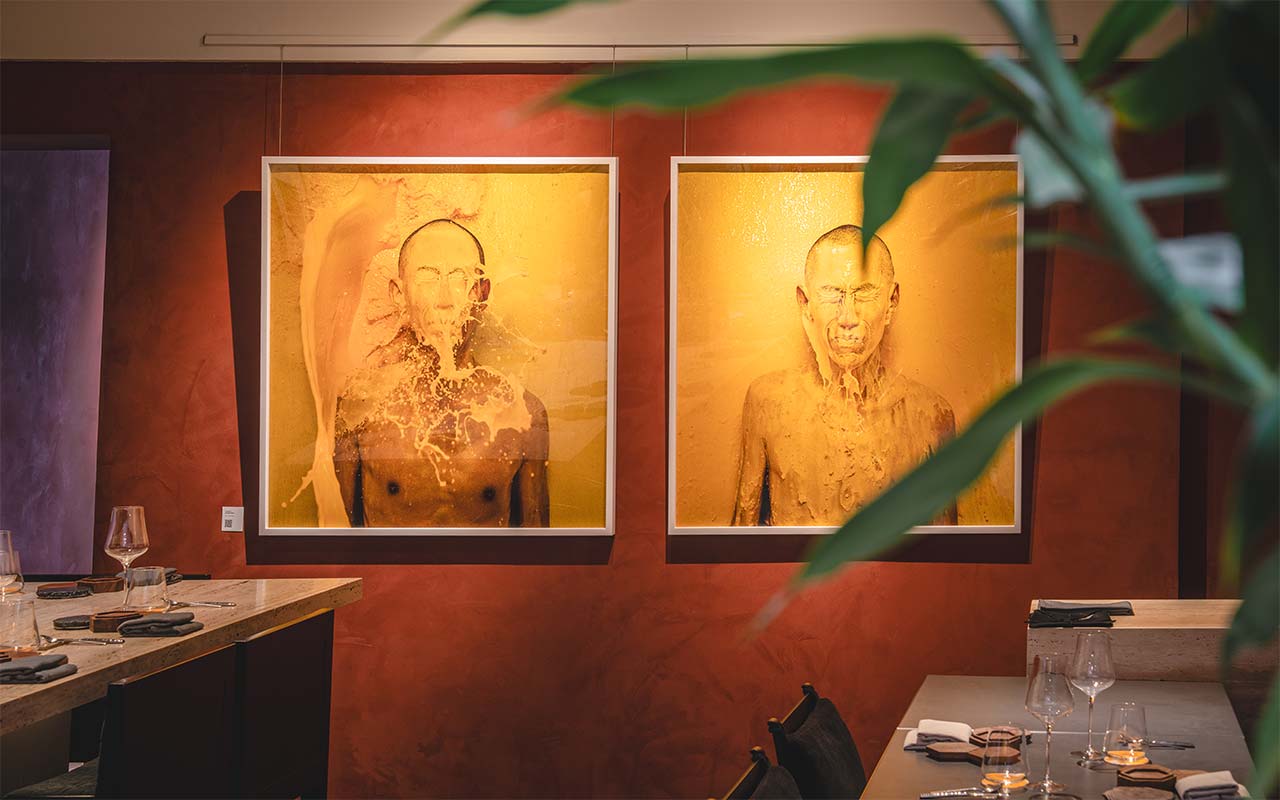Long before the packed restaurants, awards and the prestigious speaker invitations, there were two humble dinner tables. At one, located within the beating heart of São Paulo, sat Ivan Brehm, whose young mind was grappling with his multiethnic background while eating his family’s Syrian, Lebanese, German, Russian, Italian and Spanish dishes.
At another, nestled in leafy Westchester Country, New York, Selassie Atadika and her family tried to stay connected with their African roots while laying down new ones as a first-generation immigrant family.
And even though their stories unfolded a few years and almost 8,000 km apart, Brehm’s and Atadika’s formative experiences shaped similar philosophies. Both knew that food has the power to be so much more than mere sustenance. Each bite is an opportunity to inspire deeper connections.


Building community through breaking bread at Nouri
“Eating is an essential act,” says Brehm. “It is also deeply intimate and expresses a fair share of trust between the parties sharing the table, growing and preparing the food. The ritualised acts of breaking bread, of toasting, of passing food around – they strengthen the community. The willingness to sit around a table and share a meal with a stranger, by proxy, brings us closer.”
His passion to create food that inspires kinship and conversations carried him to some of the most illustrious kitchens around the world. After stints in institutions such as Thomas Keller’s Per Se in New York and Heston Blumenthal’s The Fat Duck in London, Brehm finally opened Nouri in Singapore in 2017. The restaurant has since received a Michelin star. The team also set up an additional creative interdisciplinary space called Appetite on the second floor in 2020.
“The willingness to sit around a table and share a meal with a stranger brings us closer”
This is where Brehm continues to experiment with what he calls his “Crossroads Cooking” style, creating flavours that are at once familiar and exciting. “We look for similar expressions in different cultures and use them as creative fodder,” he explains. “Sometimes the research points us in the direction of historical connections. Sometimes it highlights a more basic link, like a shared appreciation for sweet and sour. The point is to convey our links, to build a cuisine of similarities.”
Brehm’s belief is that over a meal, people may discover that they’re not so different after all.
A culinary journey through Africa by way of humanitarian work
Meanwhile, Atadika’s career began as a United Nations (UN) humanitarian worker. Helping African communities anticipate and respond to disasters took her across the continent. Along the way, she was sampling the continent’s diverse flavours, teaching herself how to cook using a research-oriented approach, as well as learning about food production.
“The lessons I learnt include the fact that Africa is currently the most plant-forward continent globally. Our diet still contains a lot of wild or foraged foods and ancient grains like millet and sorghum,” Atadika shares. “We have a low- to no-waste approach to cooking, and a long tradition of shared communal dining where families and communities even share food from one plate.”
One of her earliest forays into the culinary arts was Trio Toque, a now-defunct pop-up dining experience that had been the first of its kind in Dakar, Senegal. Thereafter, she leaned into her calling, left the UN and enrolled into the Culinary Institute of America. Now, she champions what she calls “New African cuisine” at Midunu, a Ghana-based food company that celebrates the continent’s cultural and culinary heritage through private dining events and artisanal chocolates.

“In my decade travelling around Africa, I observed many shared guiding principles in the continent’s various cuisines. At the same time, my eyes were opened to some of the challenges ahead in terms of food security and climate change. ” she says. “New African cuisine is my response to some of these problems – it’s where culture, community and cuisine intersect with environment, sustainability and economy.”
Through her work, she’s sharing the diversity of African flavours with the world. At the same time, she also hopes to uplift local communities by empowering everyone from the farmers growing indigenous crops to the women making gorgeous chocolates by hand.
An opportunity for curious palates to sample during Singapore Art Week
With both Brehm and Atadika working at the intersection of food and cultures, it was a matter of time before their paths converge. The moment arrives in the form of a collaborative dining experience titled “Crossroads of Afro-Asian Flavours”, to be held at Nouri on 18 and 19 January 2024.
This four-hands dinner coincides with “Translations: Afro-Asian Poetics”, an exhibition on African and Asian works that the restaurant will be hosting over Singapore Art Week, a major weeklong celebration of visual arts in Singapore that occurs every January.

The chefs’ excitement at the opportunity to work with each other is palpable. “I deeply respect Selassie – her way of thinking about food, but also culture and people,” says Brehm. “I’ve always wanted to do something with her in Singapore and feel that her contributions are entirely relevant to the curious palates of our guests.”
“Ivan and I met several years ago and connected on our research-oriented approach to cooking. We knew we would have to find a way to explore our approaches, and this exhibition gave us a wonderful opportunity,” adds Atadika.
Good food should make you ponder, and take your mind to somewhere new
In line with their own practices, they’re focusing on common ground when conceptualising the menu.
“It is impossible to fully represent the wonderful complexity and wealth of African and Asian food traditions,” Brehm acknowledges. “So we focused more on studying our similar ways, like the identical preparations of Southeast Asian sambal chilli paste and Ghanaian meko (a type of pepper sauce); the Filipino peanut stew kare-kare and the West African maafe; and our beloved sugee cake and semolina cake from the Maghreb.”
From sitting at their family’s dinner tables to setting their own, both chefs have found their purpose through food. And now, they’re preparing dishes that inspire a new way of seeing, tasting and understanding the world.
“Good food should be more than comfort. It should make you ponder and take your mind to somewhere new,” says Brehm. Atadika agrees. “During my time travelling around Africa with the UN, I kept seeing similarities and differences in what and how we eat. I became curious and never stopped looking for connections,” she shares. “Food brings people to the table.”
Chefs Ivan Brehm and Selassie Atadika will be hosting a four-hands dinner at Nouri on 18 and 19 January. For more information, visit the Nouri website.
The hero image features chef Brehm’s Afro-Brazilian-style fritter with turmeric and coconut curry served with a salted prawn emulsion. A version of this dish will be served as a snack in the upcoming four-hands menu. Photo: Nouri
For more information on Singapore Airlines flights to Singapore, visit the official website.
The post Standing at the culinary crossroads of Singapore and Ghana appeared first on SilverKris.
from SilverKris
No comments:
Post a Comment